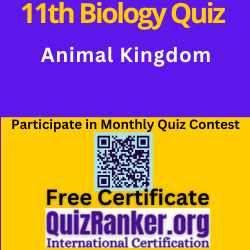Check your understanding of the Animal Kingdom MCQ Test with our 11th Biology Chapter 4 Quiz. Learn about different animal groups and their features through this easy-to-use Free Animal Kingdom Quiz.
Attempt Animal Kingdom MCQ Test
Brief Summary for Animal Kingdom
Animals are classified based on features like organization level, symmetry, cell organization, coelom, segmentation, and the presence of a notochord. Each phylum or class has unique characteristics.
- Porifera: Multicellular with cellular organization, featuring flagellated choanocytes.
- Coelenterates: Aquatic, often sessile or floating, with tentacles and cnidoblasts.
- Ctenophores: Marine animals with comb plates for movement.
- Platyhelminths: Flat-bodied with bilateral symmetry, including parasitic forms with suckers and hooks.
- Aschelminthes: Pseudocoelomate roundworms, both parasitic and non-parasitic.
- Annelids: Segmented with a true coelom.
- Arthropods: Most abundant, with jointed appendages.
- Molluscs: Soft-bodied, often with a calcareous shell and chitinous external skeleton.
- Echinoderms: Spiny-skinned with a water vascular system.
- Hemichordates: Marine, worm-like, with a body divided into proboscis, collar, and trunk.
Chapter wise biology 11th grade mcq
Chapter 1 The Living World MCQ Test
Chapter 2 Biological Classification MCQ Test
Chapter 3 Plant Kingdom MCQ Test
Chapter 4 Animal Kingdom MCQ Test
Chapter 5 Morphology of Flowering Plants MCQ Test
Chapter 6 Anatomy of Flowering Plants MCQ Test
Chapter 7 Structural Organisation in Animals MCQ Test
Chapter 8 Cell The Unit of Life MCQ Test
Chapter 9 Biomolecules MCQ Test
Chapter 10 Cell Cycle and Cell Division MCQ Test
Chapter 11 Photosynthesis in Higher Plants MCQ Test
Chapter 12 Respiration in Plants MCQ Test
Chapter 13 Plant Growth and Development MCQ Test
Chapter 14 Breathing and Exchange of Gases MCQ Test
Chapter 15 Body Fluids and Circulation MCQ Test
Chapter 16 Excretory Products and their Elimination MCQ Test
Chapter 17 Locomotion and Movement MCQ Test
Chapter 18 Neural Control and Coordination MCQ Test
Chapter 19 Chemical Coordination and Integration MCQ Test
Source for Study
Total Views: 20


